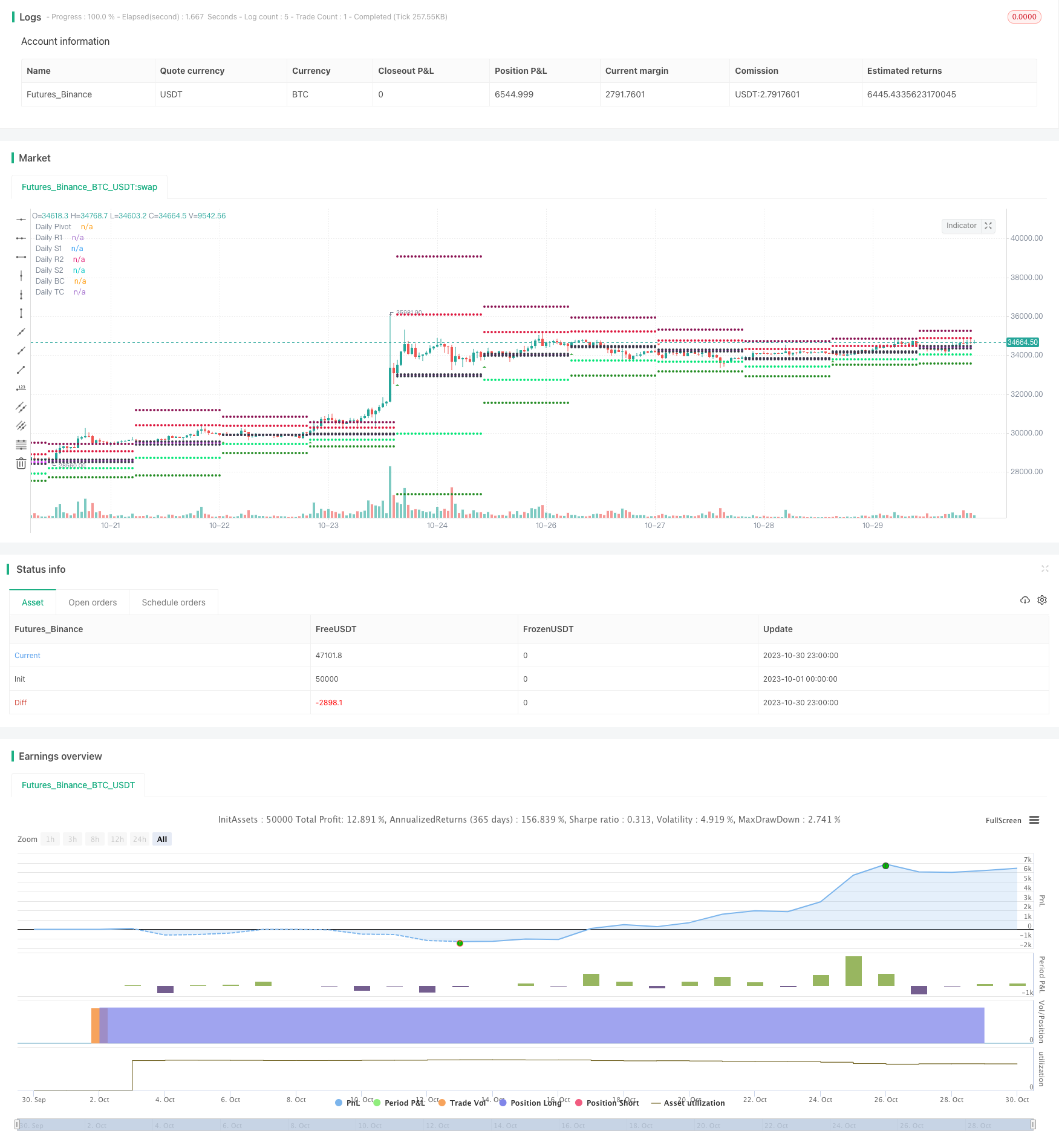
概述
该策略通过计算经典Pivot点以及利用RSI指标判断当前趋势方向,实现对 stocks的双重趋势跟踪,适用于中短线趋势交易。
策略详述
该策略主要通过以下步骤实现双重趋势跟踪:
计算经典Pivot点,包括中枢点(Pivot)、支撑1(S1)、阻力1(R1)、支撑2(S2)、阻力2(R2)等。
利用RSI指标判断股票趋势方向。RSI高于80为超买区,低于20为超卖区。
判断股票日线级别的趋势方向。如果收盘价大于前一日的R2,视为强势;如果收盘价小于前一日的S2,视为弱势。
根据日线级别趋势方向,结合Pivot点和RSI指标,制定当日的交易策略。
如果日线为强势(收盘价>R2),则在Pivot点以下观察回调买点,或在S1以下买入。
如果日线为弱势(收盘价
设置止损点。强势止损于前一日的S1,弱势止损于前一日的R1。
该策略通过计算Pivot点判断中长线趋势方向,配合RSI等指标确定短期趋势和具体入场点,实现对股价双重趋势的跟踪,适用于中短线交易。
优势分析
该策略主要优势有:
能够同时跟踪中长线趋势和短期趋势,灵活适应市场变化。
Pivot点有一定的趋势判断能力,可以有效判断中长线趋势。
RSI等指标可以判断短期超买超卖情况,辅助确定具体入场点。
策略操作规则清晰简单,容易掌握。
风险控制到位,有清晰的止损点。
风险分析
该策略主要风险有:
Pivot点存在失效的可能,无法准确判断中长线趋势。可以通过调整参数或组合其他指标来改善。
RSI等指标可能发出错误信号。可以适当调整参数,或与其他指标组合使用。
止损点设置可能过于武断,无法完全避免止损被击穿的风险。可以适当留出一定缓冲区。
策略回撤可能较大,需要有心理准备和充足资金支持。
存在过于频繁交易的风险。可以适当调整开仓条件避免过频交易。
优化方向
该策略可以从以下方面进行优化:
尝试不同的参数组合,如调整RSI的参数,优化Pivot点的计算方法等,寻找最佳参数组合。
增加或组合其他指标,如KDJ、MACD等,使信号更加准确可靠。
优化止损策略,如移动止损、离场止损等,降低止损被击穿的风险。
优化仓位管理,适当控制单笔仓位规模,降低单笔损失的影响。
优化开仓条件,避免过于频繁出入场。可以设置过滤条件等。
测试不同品种的效果,调整参数达到最佳效果。
增加自动止盈策略,以锁定利润。
总结
该策略通过计算Pivot点判断中长线趋势,并利用RSI等指标辅助判断短期趋势和具体入场点,实现对股价双重趋势的跟踪,整体运行逻辑清晰合理,中短线交易效果较好。但存在一定概率上的错误信号风险,需要进一步优化参数组合,严格控制止损来降低风险,同时适当限制仓位规模以控制 possível 可能出现的较大回撤。如果能够不断优化和完善该策略,将可以获得稳定的投资收益。
/*backtest
start: 2023-10-01 00:00:00
end: 2023-10-31 00:00:00
period: 1h
basePeriod: 15m
exchanges: [{"eid":"Futures_Binance","currency":"BTC_USDT"}]
*/
//@version=2
strategy(title="swing trade", shorttitle="vinay_swing", overlay=true)
pf = input(false,title="Show Filtered Pivots")
sd = input(true, title="Show Daily Pivots?")
//moving average
len = input(50, minval=1, title="Length")
src = input(close, title="Source")
out = ema(src, len)
//RSI INPUT
length = input( 7 )
overSold = input( 20 )
overBought = input( 80 )
price = close
vrsi = rsi(price, length)
// Classic Pivot
pivot = (high + low + close ) / 3.0
// Filter Cr
bull= pivot > (pivot + pivot[1]) / 2 + .0025
bear= pivot < (pivot + pivot[1]) / 2 - .0025
// Classic Pivots
r1 = pf and bear ? pivot + (pivot - low) : pf and bull ? pivot + (high - low) : pivot + (pivot - low)
s1 = pf and bull ? pivot - (high - pivot) : pf and bear ? pivot - (high - low) : pivot - (high - pivot)
r2 = pf ? na : pivot + (high - low)
s2 = pf ? na : pivot - (high - low)
BC = (high + low) / 2.0
TC = (pivot - BC) + pivot
//Pivot Average Calculation
smaP = sma(pivot, 3)
//Daily Pivots
dtime_pivot = request.security(syminfo.tickerid, 'D', pivot[1])
dtime_pivotAvg = request.security(syminfo.tickerid, 'D', smaP[1])
dtime_r1 = request.security(syminfo.tickerid, 'D', r1[1])
dtime_s1 = request.security(syminfo.tickerid, 'D', s1[1])
dtime_r2 = request.security(syminfo.tickerid, 'D', r2[1])
dtime_s2 = request.security(syminfo.tickerid, 'D', s2[1])
dtime_BC = request.security(syminfo.tickerid, 'D', BC[1])
dtime_TC = request.security(syminfo.tickerid, 'D', TC[1])
offs_daily = 0
plot(sd and dtime_pivot ? dtime_pivot : na, title="Daily Pivot",style=circles, color=fuchsia,linewidth=1)
plot(sd and dtime_r1 ? dtime_r1 : na, title="Daily R1",style=circles, color=#DC143C,linewidth=1)
plot(sd and dtime_s1 ? dtime_s1 : na, title="Daily S1",style=circles, color=lime,linewidth=1)
plot(sd and dtime_r2 ? dtime_r2 : na, title="Daily R2",style=circles, color=maroon,linewidth=1)
plot(sd and dtime_s2 ? dtime_s2 : na, title="Daily S2",style=circles, color=#228B22,linewidth=1)
plot(sd and dtime_BC ? dtime_BC : na, title="Daily BC",style=circles, color=black,linewidth=1)
plot(sd and dtime_TC ? dtime_TC : na, title="Daily TC",style=circles, color=black,linewidth=1)
bull1= (close > dtime_r2)
bull2= (low < dtime_pivot) or (low < dtime_s1)
bull3= dtime_pivot > dtime_pivot[1]
bullishenglufing=bull2 and bull3
bullishenglufing1=bull1 and (close > out) and (crossover(vrsi, overBought))
longCondition = bull1[1] and ((low < dtime_TC) or (low < dtime_BC) or (low < dtime_s1))
bear1= (close < dtime_s2)
bear2= (high > dtime_pivot) or (high < dtime_r1)
bear3= dtime_pivot < dtime_pivot[1]
bearishenglufing=bear2 and bear3
bearishenglufing1=bear1 and (close < out) and (crossunder(vrsi, overSold))
shortCondition = bear1[1] and ((high > dtime_BC) or (high > dtime_TC) or (high > dtime_r1))
plotshape(bullishenglufing, style = shape.triangleup, location = location.belowbar, color = green, size = size.tiny)
plotshape(bearishenglufing, style = shape.triangledown, location = location.abovebar, color = red, size = size.tiny)
if (longCondition)
strategy.entry("My Long Entry Id", strategy.long)
if (shortCondition)
strategy.entry("My Short Entry Id", strategy.short)